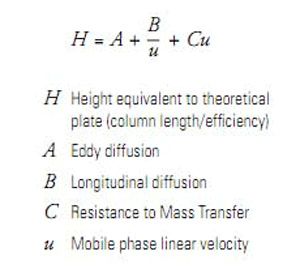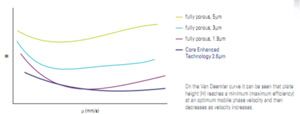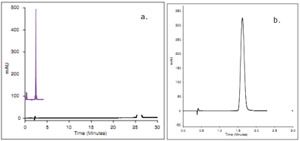Future Directions in HPLC
Janet Kelsey spoke to Stephen Luke, Product Manager at Thermo Fisher Scientific about the developments in HPLC columns and methods and the effect the growing tendency to use UHPLC has on the development of HPLC columns
Janet Kelsey spoke to Stephen Luke, Product Manager at Thermo Fisher Scientific about the developments in HPLC columns and methods and the effect the growing tendency to use UHPLC has on the development ofHPLC columns.
What challenges do HPLC analysts face today?
High performance liquid chromatography (HPLC) is one of the most reliable and heavily used analytical techniques available in the laboratory; being frequently employed to quantitate analytes within a sample, assess the quality and consistency of a chemical entity and the purity of a compound mixture. HPLC is a dynamically evolving technique, with almost continuous development in instrument technology, column geometry and stationary phase particle engineering.
Sample complexity and diversity can vary from the relatively pure and clean products of a synthetic organic reaction, to dirtier more complex biological and environmental samples. Technological developments are needed to accommodate the full range of samples and deliver the high speed, high resolution separations needed by today’s analysts.
Increasing financial pressures, faced by industry and academia alike, place an emphasis on the development of HPLC technology and techniques that allow faster separations and higher throughput analyses. In addition to this, there is a move to extend the lifetime of existing capital instruments and columns, as preserving and protecting these can significantly drive down maintenance time and costs.
What technological developments are available to help meet these challenges?
HPLC itself is an extremely robust technique; however, it is challenged by the increasing complexity of samples from rapidly growing, high demand industries such as the pharmaceutical industry. These industries are constantly evolving and require that separations are performed at high throughput levels and chromatographic efficiency.

Figure 1: The Van Deemter equation for calculating separation efficiency.
The efficiency of a separation is described by the Van Deemter equation (Figure 1), with the term H, or height equivalent to a theoretical plate. As the value of H decreases the efficiency of separation increases, giving rise to sharper peaks and improved resolution.
Recent developments in stationary phase particle engineering have given rise to solid core, superficially porous particles. These solid core particles are constructed to prevent analyte molecules from penetrating deep within them, thereby reducing the overall resistance to mass transfer seen with larger totally porous packing materials. In addition, the very tight control of particle size distribution possible with solid core particles, in conjunction with automated column packing protocols, provide greater control over the distribution of stationary phase particles within the column. As a result, the eddy diffusion term of the Van Deemter equation is reduced by the more uniform flow of mobile phase and analytes through the column. Together these developments allow for greater separation efficiency with lower backpressures than those generated by smaller particles offering similar efficiency (Figure 2).

Figure 2: Graphical representation of the change in column effiency (H) with increasing mobile phase liner velocity (µ).
In recent years ultra high performance liquid chromatography (UHPLC) has emerged as an alternative technique to traditional HPLC. Employing higher system backpressures and sub 2 µm stationary phase materials, this technique has been shown to increase productivity by reducing analysis times and maintaining peak quality. Pharmaceutical analyses performed on previous column and instrument technologies have been slower, preventing the high throughput required in fast moving research and development environments [1]. UHPLC is therefore used to increase the speed of such analyses, relying on the sub 2 µm stationary phase particles to provide the high resolution and speed that are characteristic of this technique.
While UHPLC delivers the speed and quality of separation required to meet the demands of throughput, it is fair to say that a number of additional expenses are associated with its use. Protocols applied to a UHPLC system frequently run at pressures in excess of 600 bar, a consequence of using sub 2 µm stationary phases. The strain placed upon instruments and columns when used at such pressures can lead to reduced column lifetime and the need to purchase systems that have been specifically engineered to manage the higher pressures.
What effect has the growing tendency to use UHPLC had on the development of HPLC columns?
UHPLC provides significant advantages in terms of speed, peak resolution, sensitivity and peak capacity. However, the high backpressures associated with this method can shorten the lifetime of the stationary phase material and the HPLC system itself. New columns are being developed that offer the benefits of UHPLC without increasing the backpressures.
In order to offer such benefits to chromatographers who do not have access to new instruments designed to work at high backpressures, new column designs are being made that are capable of operating with both existing HPLC and new UHPLC systems. The use of superficially porous stationary phase particles, advanced phase bonding and automated column packing methods has produced a column line which provides the separation speeds and performance advantages usually associated with UHPLC to existing HPLC systems. Such columns extend the throughput capabilities of existing instruments and can also provide advantages when used within a UHPLC system.
How do these developments impact on the applications of HPLC?
The advent of UHPLC and of solid core stationary phase particles that confer UHPLC performance onto existing HPLC systems, means that analysts are increasingly better equipped to respond to the demand for increased productivity.

Figure 3: (a) Comparative analysis of zidovudine using fully porous 5 µm stationary phase particles with a standard HPLC protocol; inset: elution of zidovudine using a fully porous sub 2 µm stationary phase material in a UHPLC protocol. (b) Isolation of zidovudine using a Thermo Scientific Accucore HPLC column with 2.6 µm, solid core, superficially porous stationary phase particles.
To use a relevant example, the anti-retroviral compound zidovudine is traditionally separated using standard HPLC techniques. Figure 3(a) demonstrates the advantage of using a fully porous, sub 2 µm column with a UHPLC protocol to elute zidovudine [2]. The UHPLC system clearly reduces analysis time from 25 minutes to below 5 minutes [2]. Figure 3(b) highlights the use of a precisely engineered 2.6 µm, solid core, superficially porous stationary phase material to isolate zidovudine. This column material eluted the compound within 1.5 minutes on a standard HPLC instrument at significantly lower backpressures than the sub 2 µm column [3].
It is clear that UHPLC provides analysts with fast, high quality separations; however, the high system backpressures, which are a consequence of using a sub 2 µm stationary phase material, place additional strain on both the column and instrument. As a result of this, UHPLC can shorten column lifetime and requires considerable investment in instruments that can operate at pressures in excess of 600 bar.
2.6 µm solid core stationary phase particles, with advanced phase bonding technology and automated column packing protocols, show increased speed of separation and robust peak resolution without elevating the system backpressures. The benefits of this technology are in retaining advanced functionality for existing HPLC systems, reduced maintenance costs and longer column lifetimes.
References
1. A. C. Wren et al., Journal of Chromatography A, 1119, 140-146 (2006).
2. http://www.separatedbyexperience.com/documents/ANCCSSYNCZIDOV_0811_v5.pdf
3. https://fscimage.thermoscientific.com/images/D02503~.pdf
Extracting Estrogenic Hormones Using Rotating Disk and Modified Clays
April 14th 2025University of Caldas and University of Chile researchers extracted estrogenic hormones from wastewater samples using rotating disk sorption extraction. After extraction, the concentrated analytes were measured using liquid chromatography coupled with photodiode array detection (HPLC-PDA).
Polysorbate Quantification and Degradation Analysis via LC and Charged Aerosol Detection
April 9th 2025Scientists from ThermoFisher Scientific published a review article in the Journal of Chromatography A that provided an overview of HPLC analysis using charged aerosol detection can help with polysorbate quantification.
Removing Double-Stranded RNA Impurities Using Chromatography
April 8th 2025Researchers from Agency for Science, Technology and Research in Singapore recently published a review article exploring how chromatography can be used to remove double-stranded RNA impurities during mRNA therapeutics production.



